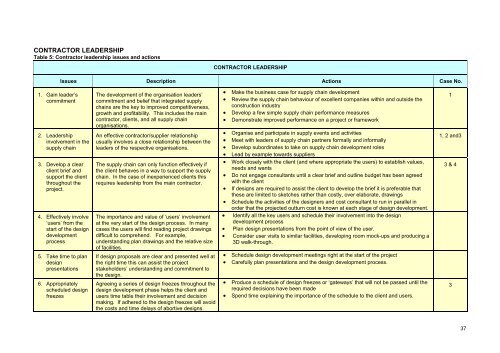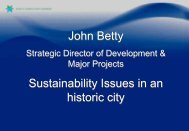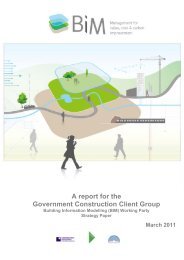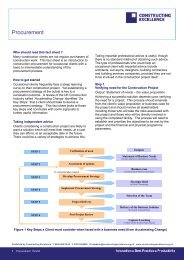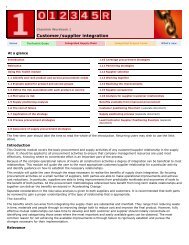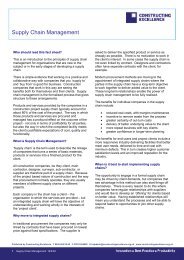Interserve Project Services Supply Chain Development
Interserve Project Services Supply Chain Development
Interserve Project Services Supply Chain Development
You also want an ePaper? Increase the reach of your titles
YUMPU automatically turns print PDFs into web optimized ePapers that Google loves.
CONTRACTOR LEADERSHIP<br />
Table 5: Contractor leadership issues and actions<br />
1. Gain leader’s<br />
commitment<br />
CONTRACTOR LEADERSHIP<br />
Issues Description Actions Case No.<br />
2. Leadership<br />
involvement in the<br />
supply chain<br />
3. Develop a clear<br />
client brief and<br />
support the client<br />
throughout the<br />
project.<br />
4. Effectively involve<br />
‘users’ from the<br />
start of the design<br />
development<br />
process<br />
5. Take time to plan<br />
design<br />
presentations<br />
6. Appropriately<br />
scheduled design<br />
freezes<br />
The development of the organisation leaders’<br />
commitment and belief that integrated supply<br />
chains are the key to improved competitiveness,<br />
growth and profitability. This includes the main<br />
contractor, clients, and all supply chain<br />
organisations.<br />
An effective contractor/supplier relationship<br />
usually involves a close relationship between the<br />
leaders of the respective organisations.<br />
The supply chain can only function effectively if<br />
the client behaves in a way to support the supply<br />
chain. In the case of inexperienced clients this<br />
requires leadership from the main contractor.<br />
The importance and value of ‘users’ involvement<br />
at the very start of the design process. In many<br />
cases the users will find reading project drawings<br />
difficult to comprehend. For example,<br />
understanding plan drawings and the relative size<br />
of facilities.<br />
If design proposals are clear and presented well at<br />
the right time this can assist the project<br />
stakeholders’ understanding and commitment to<br />
the design.<br />
Agreeing a series of design freezes throughout the<br />
design development phase helps the client and<br />
users time table their involvement and decision<br />
making. If adhered to the design freezes will avoid<br />
the costs and time delays of abortive designs.<br />
• Make the business case for supply chain development<br />
• Review the supply chain behaviour of excellent companies within and outside the<br />
construction industry<br />
• Develop a few simple supply chain performance measures<br />
• Demonstrate improved performance on a project or framework<br />
• Organise and participate in supply events and activities<br />
• Meet with leaders of supply chain partners formally and informally<br />
• Develop subordinates to take on supply chain development roles<br />
• Lead by example towards suppliers<br />
• Work closely with the client (and where appropriate the users) to establish values,<br />
needs and wants<br />
• Do not engage consultants until a clear brief and outline budget has been agreed<br />
with the client<br />
• If designs are required to assist the client to develop the brief it is preferable that<br />
these are limited to sketches rather than costly, over elaborate, drawings<br />
• Schedule the activities of the designers and cost consultant to run in parallel in<br />
order that the projected outturn cost is known at each stage of design development.<br />
• Identify all the key users and schedule their involvement into the design<br />
development process<br />
• Plan design presentations from the point of view of the user.<br />
• Consider user visits to similar facilities, developing room mock-ups and producing a<br />
3D walk-through.<br />
• Schedule design development meetings right at the start of the project<br />
• Carefully plan presentations and the design development process.<br />
• Produce a schedule of design freezes or ‘gateways’ that will not be passed until the<br />
required decisions have been made<br />
• Spend time explaining the importance of the schedule to the client and users.<br />
1<br />
1, 2 and3<br />
3 & 4<br />
3<br />
37


